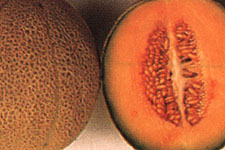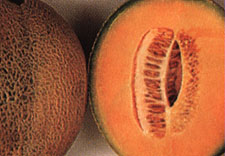

PMR 45 Topscore


FoodFood InformationFruitMelons
The cantaloupe, a golden-fleshed melon, is the most reliable and least
costly melon on the fruit stand when in season. While it takes some know-how
to identify top quality in most of the other varieties, selecting a fine
cantaloupe is comparatively easy. All you have to do is select high color
(yellow), not bruised, firm melons and allow them a few days to ripen at
room temperature. You'll know when they are ripe because they'll give slightly
to gentle pressure and will have increased fragrance. Of course, if you
settle for soft, soupy, banged-up, moldy melons or those that are grass-green,
all bets are off.
Cantaloupes are available year-round but are at peak of season from June
through November. In December, January, and February they are imported from
Central America and some of the islands in the Caribbean, but these imports
are usually overpriced and under flavored. In this three month period, when
all the other varieties of melons are similarly poor and costly, your best
bet is to use the far less costly and less risky grapefruit in place of
melon.
In February, March, April, and May Mexican cantaloupes are available. These
are of better quality but are not always reliable. They too are usually
overpriced.
In June the California cantaloupes come on line, and they don't bow out
until December. California not only grows the world's finest cantaloupes,
usually supplies are more than ample to satisfy the demand and prices are
modest. When California cantaloupes are in season, skip the grapefruit.
In that time span the grapefruit are below par and high in price. Cantaloupes
have a low calorie count and are popular with dieters.
Cantaloupes are grown in many areas of the United States. The farther west,
the better the melon. Arizona also grows fine melons. Texas cantaloupes
used to be mediocre, but in recent years they have become quite good. As
a rule, the cantaloupes grown in the rest of Dixie are no bargain. Most
grown east of the Mississippi are long on size and short on flavor. Nearly
all are sold locally. There is one exception worth noting: There is a grower
named Hand who produces melons in northern New York State. Hand melons are
famed for their flavor and texture. However, the demand usually exceeds
the supply. They seldom reach the wholesale markets. Hand usually sells
his entire crop during the Saratoga racing season.
WHEN TO BUY: At peak June through November
WHAT TO LOOK FOR: Firm, not bruised fruit with light-yellowish slim.
HOW TO STORE: Ripen at room temperature then refrigerate




Deamer 5/97